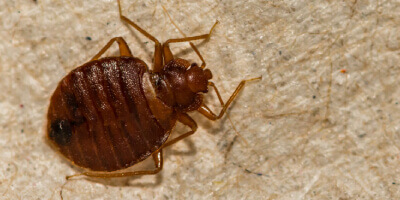Bed Bug Facts & Information
Everything you need to know about bed bugs
WHAT DO bed bugs LOOK LIKE

Bed bugs are an oval shape and only grow to about 3/16th of an inch in length. Prior to feeding, they are brown and flat. After feeding, bed bugs become redder in color, swollen, and elongated. Bed bugs have 6 legs and 2 antennae. Despite having reduced “wing pads,” bed bugs do not have wings and cannot fly. Adult bed bugs are visible to the human eye and can be detected by sight, especially within mattress seams and box springs. Bed bug nymphs can be harder to identify, as they are smaller in size and paler in color.
Bed bugs are active mainly at night and usually bite people while they’re sleeping. They feed by piercing the skin and withdrawing blood through an elongated beak. The bugs feed from three to 10 minutes to become engorged and then crawl away unnoticed. Most bedbug bites are painless at first, but later turn into itchy welts. Bed bugs can multiply very quickly and spread to other rooms in your home, which is why you need bed bug treatment at your home as soon as you see one.
Bed bugs are most easily identified by small reddish-brown fecal spots on mattresses, upholstery, or walls. If these spots are found, it can indicate an infestation. Bites on the arms and legs are also a tell-tale sign of bed bugs. While these bites can be small, if they swell and become itchy, they are noticeable. It can take two to three days for bed bug bites to appear, allowing the infestation to grow.
Infestations can also be identified by sightings of bed bug molt skins, their eggs, empty eggshells, or the bugs themselves. All these things are quite small, but still visible to the human eye and certainly easier to spot by the trained eye. Both bed bug’s molted skins and their eggshells appear pale white after molting or emerging from the eggshell. Bites alone do not indicate an infestation without other bed bug evidence. But odds are, where there is one bed bug, there is more.
Bed bugs are active mainly at night and usually bite people while they’re sleeping. They feed by piercing the skin and withdrawing blood through an elongated beak. The bugs feed from three to 10 minutes to become engorged and then crawl away unnoticed. Most bedbug bites are painless at first, but later turn into itchy welts. Bed bugs can multiply very quickly and spread to other rooms in your home, which is why you need bed bug treatment at your home as soon as you see one.
Bed bugs are most easily identified by small reddish-brown fecal spots on mattresses, upholstery, or walls. If these spots are found, it can indicate an infestation. Bites on the arms and legs are also a tell-tale sign of bed bugs. While these bites can be small, if they swell and become itchy, they are noticeable. It can take two to three days for bed bug bites to appear, allowing the infestation to grow.
Infestations can also be identified by sightings of bed bug molt skins, their eggs, empty eggshells, or the bugs themselves. All these things are quite small, but still visible to the human eye and certainly easier to spot by the trained eye. Both bed bug’s molted skins and their eggshells appear pale white after molting or emerging from the eggshell. Bites alone do not indicate an infestation without other bed bug evidence. But odds are, where there is one bed bug, there is more.
Where are bed bugs found
These elusive pests can be found nearly anywhere inside a home, car, bus, or other shelter. In hotels, the most common place to find bed bugs is within the backside of headboards that are mounted on walls. Bed bugs can be found in any location where humans congregate and spend extended time. Bed bugs are excellent at traveling well hidden. They will latch onto suitcases, boxes, shoes, pant legs, and other items and travel on the objects to a new home. Once introduced into a new environment, they will spread throughout their new surroundings, whether it be a large building or a single-family home.
Bed bugs can take up residence in many places besides beds, such as the cracks and crevices in walls or wood. They also like to hide behind baseboards, around mattress buttons, within bedding, and inside box springs. Bed bugs can even hide inside electrical switch plates, and behind picture frames and wallpaper. They are also very resilient pests. It’s possible for adult bed bugs to go several months without a blood meal. They also can withstand temperatures from nearly freezing up to 122 degrees Fahrenheit, allowing them to survive in harsh conditions.
Bed bugs can take up residence in many places besides beds, such as the cracks and crevices in walls or wood. They also like to hide behind baseboards, around mattress buttons, within bedding, and inside box springs. Bed bugs can even hide inside electrical switch plates, and behind picture frames and wallpaper. They are also very resilient pests. It’s possible for adult bed bugs to go several months without a blood meal. They also can withstand temperatures from nearly freezing up to 122 degrees Fahrenheit, allowing them to survive in harsh conditions.
How did I get bed bugs
Besides being excellent hiders, bed bugs are also excellent hitchhikers. They will get into bags and luggage – including backpacks and purses – to make their way into your home. Since they are attracted to blood, they will do anything they can to get in where there is a blood meal. And bed bugs don’t have anything to do with cleanliness. They aren’t attracted to dirt or grease. So, you could easily have brought them home from a nice hotel or even a library or theater.
Since bed bugs excel at hiding, you mostly see the bites before you actually see the bug. They can hide in the seams of chairs and couches, between cushions, in the folds of curtains. They can also hide in drawer joints, in electrical receptacles and appliances, and even under loose wallpaper and pictures on the wall. They can hide in the head of a screw so it’s not surprising that they can also hide in your bed.
Since bed bugs excel at hiding, you mostly see the bites before you actually see the bug. They can hide in the seams of chairs and couches, between cushions, in the folds of curtains. They can also hide in drawer joints, in electrical receptacles and appliances, and even under loose wallpaper and pictures on the wall. They can hide in the head of a screw so it’s not surprising that they can also hide in your bed.
what Problems do bed bugs cause
Although bed bugs can dine on many warm-blooded animals, they prefer to feed on humans. Because their bites are nearly painless, you may not notice or even wake up when bitten. That allows them to multiply before you realize you have them. Bed bugs don’t transmit disease, but their bites can cause red, itchy welts. These bites do not need professional treatment, and people who experience severe itching usually can find relief with topical, over the counter itch creams. You can get a steroid cream from your doctor if you’re particularly sensitive to bed bug bites.
Perhaps the most alarming feature of bed bugs is their fast-reproductive nature. Females lay 1-5 eggs per day, reaching up to 541 eggs in their lifetime. It only takes about 21 days for these nymphs to become adult bed bugs. If a bed bug population goes undetected, these bugs can quickly infest an entire household or building. And once established, an infestation can be extremely difficult to get rid of.
Perhaps the most alarming feature of bed bugs is their fast-reproductive nature. Females lay 1-5 eggs per day, reaching up to 541 eggs in their lifetime. It only takes about 21 days for these nymphs to become adult bed bugs. If a bed bug population goes undetected, these bugs can quickly infest an entire household or building. And once established, an infestation can be extremely difficult to get rid of.
How can I prevent bed bugs
Since bed bugs can be just about anywhere, bringing them home with you from anywhere is likely. It’s important to be on the lookout for bed bugs when using public transportation, sitting in public spaces like libraries, or going to the theater. In particular, hotel rooms should be thoroughly inspected before sleeping in the bed. Check the bedsheets for those tell-tale blood spots or sightings of the bugs or eggshells. Use a small flashlight to assist with visual inspections. Because bed bugs also tend to travel easily, be sure to vacuum suitcases and inspect for any signs of bed bugs upon returning from a vacation. Also consider bringing a large trash bag to keep your suitcase in during hotel stays and wash clothes on hot cycles once you return home, even those that haven’t been worn.
100% Satisfaction Guarantee
24-Hour Guaranteed Response
Board Certified Entomologists
Consider bed bugs controlled.
GET MY QUOTE
